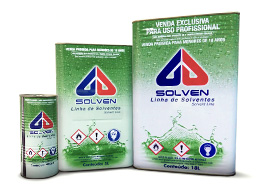
Solven Raz Specification and Safety Information
DESCRIPTION
It is a colorless, flammable liquid, free of suspended materials. It is mainly composed of aliphatic hydrocarbons. It has low aromatics and sulfur content.
PROPERTIES
See the tests, specification, Solven method and reference method in the PDF file available for download.
APPLICATION / MAIN USES
Used in dry cleaning process, formulation of paints and varnishes, degreaser and other applications tested by the customer.
PACKAGING, STORAGE AND HANDLING
Product considered FLAMMABLE and must be kept away from sources of ignition, in a cool, dry place, protected from bad weather. The supply is made through drums, cans, cans, containers and in bulk. The shelf life of this product is 24 months from the date of manufacture, under the recommended storage conditions and/or original packaging.
CLASSIFICATION FOR TRANSPORT
UN number: 1268.
Proper shipping name: Petroleum Distillates. HUH.
Risk class / division: 3.
Risk number: 30.
Subsidiary risk: N.A.
Packing Group: III.
ADOPTED CLASSIFICATION SYSTEM
Standard ABNT-NBR 14725-Part 2: 2009. Adoption of the Globally Harmonized System for the Classification and Labeling of Chemicals, UN.
STORAGE
P402+P403+P404 Store in a dry place. Store in a well-ventilated place. Store in a closed container.
PHYSICAL AND CHEMICAL PROPERTIES
Aspect:
- Physical state: Liquid;
- Appearance: Clear;
- Color: Slightly Yellow.
Odor: Low odor, but characteristic of hydrocarbons.
Odor threshold: Not available.
pH: Not Applicable.
Melting point/freezing point: Not available.
Initial boiling point and boiling temperature range: 110 °C (EN ISO3405).
Flash point: > 25°C Open Vessel.
Evaporation rate: Not available.
Flammability: Not Available.
Lower/upper limit of flammability or explosiveness: Upper (LSE): 6.0% / Lower (LIE): 0.9%.
Vapor Pressure: Not Available.
Vapor Density: Not Available.
Relative density: 0.750 (water as standard).
Solubilities: Miscible – common organic solvents / Immiscible – in water.
Partition coefficient – n-octanol/water: Not available.
Auto-ignition temperature: Not available.
Decomposition temperature: Not available.
Viscosity: Not Available.
STABILITY AND REACTIVITY
Reactivity: Not Available.
Chemical stability: Stable under normal conditions of use.
Possibility of hazardous reaction: Not available.
Conditions to Avoid: Heat, ignition sources, incompatible materials.
Incompatible Materials: Strong Acids, Strong Oxidizing Agents, Nitric Acid, Halogenated Hydrocarbons.
Hazardous Decomposition Products: Carbon Dioxide (CO2) and Carbon Monoxide.
TOXICOLOGICAL INFORMATION
Acute toxicity:
- Skin Corrosion/Irritation: Repeated or prolonged contact may dry out and cause mild skin irritation;
- Serious eye damage/eye irritation: May cause mild irritation on contact with eyes;
- Respiratory or skin sensitization: Inhalation of vapors causes respiratory and mucosal irritations. In high concentration its vapors cause irritation and narcotic effects on the central nervous system;
- Germ cell mutagenicity: Insufficient information for classification;
- Carcinogenicity: Insufficient information for classification;
- Reproductive toxicity: Insufficient information for classification;
- Specific target organ toxicity – single exposure: Toxicological assessment: The substance or mixture is classified as specific target organ toxicant, single exposure, category 3, with respiratory tract irritation. May cause drowsiness and dizziness;
- Specific target organ toxicity – repeated exposure: Insufficient information for classification;
- Aspiration Hazard: Product can enter lungs and cause damage such as: Chemical Pneumonia.
ECOLOGICAL INFORMATION
Ecotoxicity: Not Available.
Persistence and Degradability: Not Available.
Bioaccumulative Potential: Not Available.
Mobility in soil: The product easily infiltrates the soil and evaporates quickly.
Other Adverse Effects: Do not allow to enter soil, rainwater or sewers.
CONSIDERATIONS ON FINAL DESTINATION
Recommended disposal methods: This product can be reprocessed, incinerated in suitable facilities or sent for co-processing. Check in your Municipality and/or in your State, the applicable legislation on final disposal.
Used packaging: When the container is empty, contaminated with the product, it can be sent to packaging recycling companies authorized by the environmental agency.